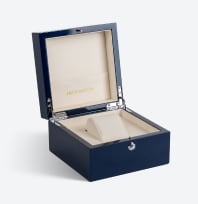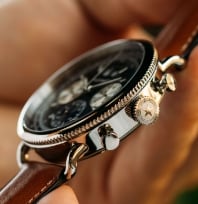Watches make fantastic statement pieces. They are mechanical works of art worn on your wrist that can add class to any outfit. But getting into watches can be overwhelming; there is a lot of terminology that gets thrown around, and it can be difficult to understand all of it at first.
Jack Mason is here to help unpack a little bit of that and to teach you about automatic watches and what sets them apart from the rest.
A Broad Overview of Watches
When first picking a watch, there are two big choices to make when it comes to what kind of watch you want. The first is to choose between a quartz watch and a mechanical watch.
Quartz Watches vs. Mechanical Watches
Quartz watches have a small battery inside that is used to power the movement, the movement being the internal mechanism of the watch that causes the hands to move. Mechanical watches lack a battery, and instead, their movement is powered by the assortment of gears inside.
This is when you have to make your second big choice; choosing between a manual winding and an automatic watch.
Manual Winding vs. Automatic
Manual winding watches require you to, as the name implies, manually wind up the mainspring, which powers the movement via a crown on the side of the watch face. The mainspring is a spring that's nestled inside of the watch that, as the crown is wound, will get tighter and tighter. The unwinding of that tension is what makes the hands move. And as that tension is gradually lessened throughout the day, each second that goes by means another tick, and the "battery" runs lower and lower.
Most mechanical watches have a life anywhere between twenty hours or forty hours. Some extremely high-end watches can last for seventy hours. But no matter how long the battery is, you're still typically winding your watch every other day. Automatic watches can have a significantly longer battery life as the mainspring is "recharged," in a sense, by the natural movement of your arms swinging. Let's go into some detail on how that works now.
How Does an Automatic Watch Generate Power
The idea is that an automatic watch can take the natural kinetic energy from the movement of your arm and wind the mainspring with it. A semi-circular weighted rotor on the inside of the watch is connected to the mainspring through a series of gears. That way, as your arm moves, so does the rotor. When the rotor makes a rotation, the mainspring is wound tighter and tighter.
The best part of this is that if you're wearing an automatic watch, you will no longer have to wind your watch every day, or even every other day. Oftentimes you can wear your watch for several weeks at a time without needing to manually wind it again.
This does come with two downsides. One is that the watch is naturally thicker than its manually-wound counterparts, as it has the additional component of the rotor inside. The other is that you then have to wear that one watch every day if you want to get the most out of that automatic winding functionality.
Info on Winding an Automatic Watch
When you first purchase an automatic watch, you'll need to do a bit of hand-winding to get the mainspring going, as there probably hasn't been enough kinetic energy to keep it wound. To do this, just push the crown (the circular knob on the side of the watch) all the way in and turn it clockwise. This will wind the mainspring.
The only time this differs is if the automatic you purchased is a sports watch. These are designed to have their crowns screwed in so that they can't break off and damage the movement if the watch is hit. To wind, the mainspring just unscrews the crown out a bit from the case, and then you should be able to wind it normally.
One of the more frequently asked questions is, "Is it possible to overwind in an automatic watch?" This is an issue that can crop up with normal hand-wound watches. With those, if you are hand winding and you don't notice the increasing tension, it's possible to damage the internal mechanism. Fortunately, this is not something you'll have to worry about with most automatic watches.
How to Choose an Automatic Watch
Watches are in a really interesting place right now. It's never been easier to know exactly what time it is. It's on our phones; it’s on our computers; it's even on our ovens. But watches remain as popular as ever. And the reason for that is twofold.
Firstly, there are circumstances where having a watch is a necessity. Divers use them to check how long they've been under the water for, soldiers in the field use them as an analog replacement to tell the time, sailors use them in extended trips; there are scenarios where watches just tell the time better than a phone.
And secondly, watches are amazing fashion pieces. They can radically enhance an outfit, they can make conversation pieces, and so, in the same way that suits will never go out of style, watches will be around for a long, long time.
Kevin O'Leary, of Shark Tank fame, is also a renowned watch collector, and his collection is valued in the millions. He has a quote that expresses his philosophy on watches, saying, "I don't care about telling the time, I care about the dial. I use my phone to tell the time." This works for him because he's most likely wearing watches during business meetings, while filming, or going out on the town. The practicality of the watch isn't a concern for him because it's not something that he has to worry about.
But of course, not everyone has the life of luxury that Mr. Wonderful has. Some people need, or just want, practicality, a timer, a calendar function, a barometer, a star chart, or maybe even the phases of the moon. What's most important is to find what matters the most to you and to think about when and why you'll be wearing this timepiece. And, while there's nothing wrong with wearing a watch just because it's beautiful, it's also important to know how to style it.
How to Style an Automatic Watch
When purchasing a watch, you need to think about why and when you'll wear it. Try and match your watch with the scenario you'll most likely be wearing that watch in and the outfit that that activity might require. Let's take a look at a couple of common scenarios now.
Sports Watches
As the name implies, it's impossible to go wrong with a sports watch. These typically have their crowns screwed into the case so that, no matter how hard it gets hit, it won't break off into your movement and destroy the internal mechanism.
If you live by the seaside and enjoy sailing or diving, a diving watch makes an excellent choice as they typically have the best water-resistance ratings.
Everyday Wear
A common everyday watch would be one comprised of a stainless steel face and bracelet because they're simple, beautiful, and pair with almost any outfit. As they’re made from stainless steel, they also benefit from being incredibly durable.
Another excellent option would be a field watch. Field watches were originally made for soldiers in WW1 but retained their popularity because they're well constructed, sturdy, and still manage to look great. They often come with canvas straps, which can pair easily with anything from simple outdoor wear, to beachwear, to jeans and a casual button-up shirt. Just make sure to get a strap and dial that don't clash with the typical colors of your wardrobe.
Formal Wear
For the office, try a leather strap. If you can, try and find leather that matches your belt and shoes, as that will create a very cohesive look and elevate your outfit. If you often find yourself at black-tie events, simple is often be better. Try a black leather band paired with a simple white face. In those situations, you don't want the watch to be too distracting from the rest of the outfit.
Automatic watches make excellent starter watches. Just be sure to wind it every so often if not wearing it every day, and try and match your watch with the outfits you might most frequently wear it in.
Sources:
What is kinetic energy? | Khan Academy












